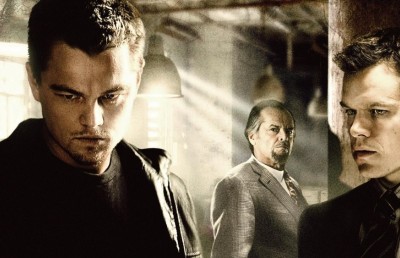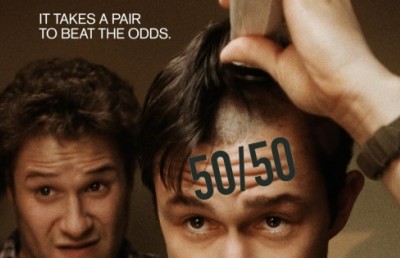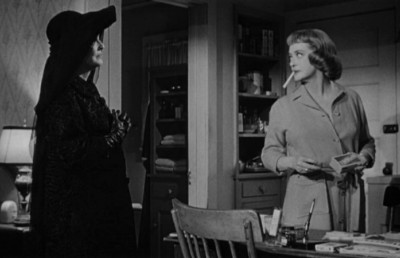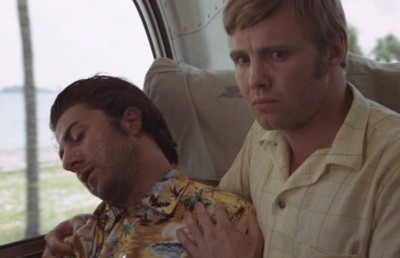Herzog and Kinski: Taming the Madman
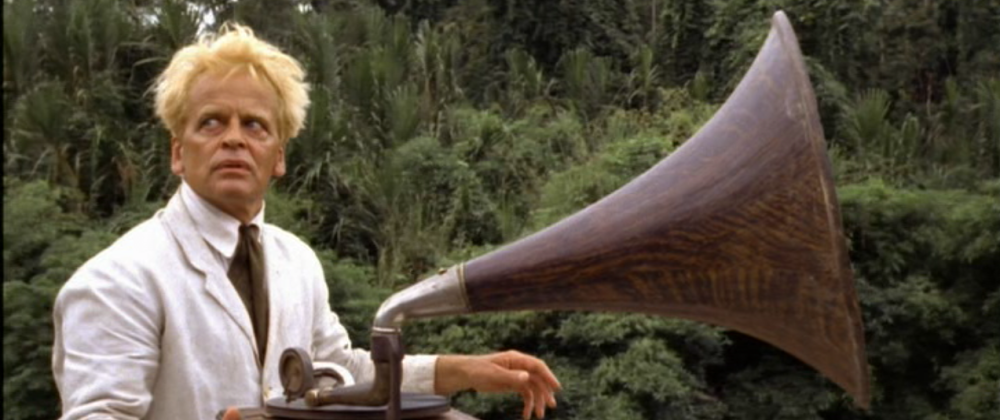
Throughout the history of cinema there have been many great actor/director collaborations. One of these is undoubtedly the pairing of Werner Herzog and Klaus Kinski. This collaboration began with Aguirre, The Wrath of God (1972), in which Kinski plays a man driven by maniacal ambitions of finding the fabled El Dorado, conquering South America, impregnating his daughter, and reigning with her over a new kingdom. In terms of a character who is able to feel or inspire empathy, partake of functional romantic relationships, or repress various primal urges, they clearly began at ground zero. However, across their next three films together the main character, always an outsider, finds himself increasingly integrated into the world through his relationship with a woman, with the issue of self control always closely tied to this dynamic. While the women of Nosferatu (1972) and Woyzeck (1972) provide a much needed refuge for the protagonist, they are unable to offer lasting salvation. While the Kinski persona does take a step towards sustainable happiness between these films, it is not until Fitzcarraldo (1982) that Kinski finds a satisfactory union with a woman. Ignoring their fifth and final film, Cobra Verde (1989), which does not conform to this development and is widely and rightly regarded to lack the artistic merit of their other collaborations, this essay looks at how aspects of Kinski’s performance relate to this thematic development across their middle films.
In Nosferatu when Harker (Bruno Ganz) first arrives at the castle, he is greeted by Nosferatu (Kinski), who has arranged for his supper. In this scene, Kinski reveals his internal battle to control his desire to have Harker, and the suffering that goes with this denial through a series of engagements that follows a pattern of overengagment–disengagement–amplified overengagment. Early in the scene, Kinski pours wine into his guest’s glass without stopping to gaze at Harker, who in turn remains fixated on the glass. These eyeline directions invert how this type of situation would normally unfold; the person pouring usually looks at the glass as the one with the glass observes the person with the bottle. Kinski’s focus and desire are too intense to allow distractions from his object of desire, and Harker attempts to avoid this overengagment.
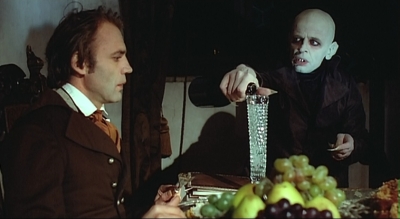
For the next half minute Harker hungrily and obliviously devours his dinner, an action which might be termed a ‘fang’ tease. During this half minute Kinski does not blink, reinforcing his focused lust and otherworldly nature. During this time twice, but almost imperceptibly, he raises his upper lip and squints his eyes, an external action suggestive of his internal desire to have his way with Harker. It is the kind of small facial gesture wonderfully suited to screen acting. Harker looks up twice and, while aware that he is being watched, is able to continue eating. Howling wolves temporarily disengage Kinski from Harker, but in a way that also rekindles his killer instinct and desire. As Kinski listens to these cries, he registers an expression which subtly evokes both desire and the pain of denying oneself primal urges. He summarizes these sounds, “the children of the night make their music,” and looks back to his dinner guest. In an especially comic moment, Harker looks ahead baffled by this comment, suspecting that something is seriously amiss with his host. The comment also increasing the degree to which he is being overengaged. Kinski comments “you are like the villagers, who cannot place themselves in the soul of the hunter,” and then begins reviewing the documents Harker placed on the table, to complete this three part interaction. Rather than hold his head still and move his eyes, as most would do, he shakes his head back and forth horizontally. On a subtextual level, this action reveals that he is fighting the urge to have Harker, and is in effect saying ‘no’ to his thirst for blood, as the head motion is that used when people wish to indicate no without speaking.
A few moments later, when Harker cuts himself with the bread knife, Kinski’s response follows a similar three part pattern. First, there is the revelation of his desire and a moderate over-engagement of Harker, who rejects his host’s offer to suck his finger as a safety precaution against rust poisoning. In a wonderfully comic moment, Kinski states to Harker that it is the “oldest remedy in the world,” a line which attempts to normalize the action by recourse to tradition and reveals his awareness that putting his guests’ finger in his mouth might constitute a breach of societal norms (in a related sense, part of what makes the scene from the above paragraph so comical is the way it violates rules of etiquette, primarily ‘don’t stare’). When Harker refuses, Nosferatu disengages him by turning away. Unable to repress himself any longer, the count spins round and pulls the finger to his mouth, for an amplified over-engagement of the guest. Rather than pulling his finger away immediately, however, Harker allows Kinski about three seconds worth of blood before retracting his arm, a pause which is presumably sustained because to pull back immediately might appear rude.
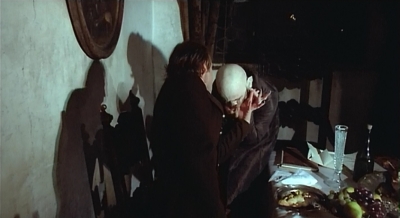
After a pause, Kinksi slams a chair against the table and walks towards Harker, who stumbles backwards while looking around, one would think for an escape route, though from his upward glances it seems instead that he is taking a sudden interest in Dracula’s taste in chandeliers and art. He finally backs into a chair and Kinski sits facing opposite him. Kinski’s facial expression, like the earlier shot with the wolves, restates and slightly heightens the suffering he endures in holding off his desire to drink deeply. As we learn from the story, Dracula’s reason for keeping Harker alive is that he will need him as a pawn in his attempt to win over Lucy (Isabelle Adjani), a narrative element which connects successful self control with obtaining a desired interaction with a woman.
When Kinski first arrives to meet Lucy, the overt meaning of the scene suggests that she is rejecting him, but a number of elements reveal her erotic desire. The scene is essentially part of a courting ritual. Upon his entry to her bedroom, Adjani jumps to her feet with a gasp of breath, an action which indicates her sense of surprise and fear, while also suggesting that she is rising up to challenge or engage him. After a brief exchange, she looks away and begins speaking, saying that “stars spin and reel in confusion, time passes in blindness, rivers flow without knowing their course.” The manner in which she is looking away from Dracula suggests that she is attempting to repress erotic desire by not directly addressing its source.
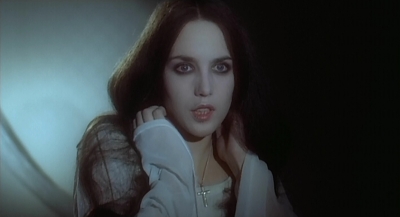
Lucy’s ‘attraction to and repulsion from’ Dracula
Based on this, we understand her comments to be a description of her own enraptured state, which is perhaps confusing to her because she had not consciously anticipated desire for Dracula. Her internal division and confusion is nicely reinforced by the way in which she appears to be looking at herself in the mirror from a frontal position, thought her reflected image is looking off to the side (an effect obtained because her mass of hair conceals the slight turn of her head). The second way she reveals her desire for Dracula arises in the way she first conceals her neck, and then slowly removes her hands, suggestively running them through her hair as she relaxes her shoulders. On an overt level, this action moves from a position which protects her neck from his rather menacing overbite to one that reveals the gold cross hanging from her necklace. But the action also implies her desire to yield, that she is revealing her neck because she wants him to dig in. Rather than defiance, her facial expression is one of mesmerized desire. That she finds Dracula tempting is, by inference, overtly stated when, during this gesture, she comments that “even the unthinkable will not deter me.” This ‘unthinkable’ seems to refer to the act of yielding to Dracula, and by saying that this possibility will not deter her she acknowledges it as a possible temptation. This is a rather unfortunate piece of dialogue; the way in which the script tells us what the acting has already shown us only undermines the overall eroticism of the scene. The scene ends with a shot in which she raises her hand to her breast. The way in which one hand appears to move the other suggests both her erotic arousal and internally divided state.
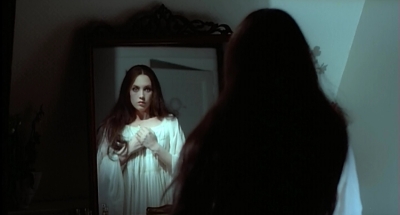
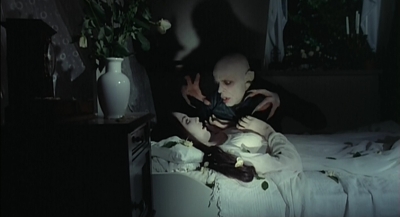
Not long after this interaction Dracula again enters her bedroom. This time she is lying on the bed, waiting for his arrival and ready to yield. He hovers over her, lowers to his knees, and is about to quickly move in on her neck when she places her hands against his chest. Her hesitation logically suggests fear, though the manner in which she lowers her arm to her side in a slightly exaggerated way seems to request he acknowledge the rest of her body before getting to the good stuff. Kinski slowly retracts his outstretched fingers as his gaze, following her arm, traces down her body. Her breathing becomes pronounced and erratic as he runs his hands up her legs. As he begins to move his head toward her pelvic area with a look of unsettling curiosity and blunted awareness, she pulls him close to her upper body. The way in which she does this simultaneously suggests a revulsion for what he is doing and a sense that he has, however indelicately, aroused her desire through the necessary foreplay and, through this commingling of impressions, evokes both the erotic and the grotesque. She pulls him close, slowly tilting her head back, as his left hand palms her breast. As this hand moves over her, she lets her arm slide down his, as if showing approval for his choice of hand placement. This moment recalls the concluding shot of their interaction by the nightstand which, in light of this moment, could be interpreted to suggest that she was fantasizing about Dracula. Kinski’s first bite is masterful. He suspends his head above her neck for about three seconds, during which his right hand slides down over her face. He then moves his head down with a sudden jerk and, after a moment, opens his eyes wide and deftly adjusts his mouth and head in a way that perfectly indicates his response to her sudden rush of blood. Dracula remains by her bedside for most of the night. At one point he tries to get up to leave, his face registering a dim awareness of the rising sun, but Adjani pulls him back to her neck to keep him in place until the sun can provide him with a more lasting departure. He is unable to depart her bedside. His inability to control himself, to resist her, becomes the cause of his demise.
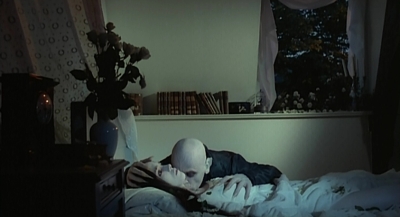
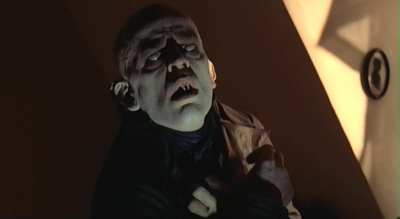
Dracula’s insatiable love leads to his demise
In Woyzeck, the unfolding action of one scene reveals how Kinski has attained some degree of protection and refuge with a woman, though the precarious nature of this security is also highlighted in a way that causes Kinski agitation and will ultimately be the catalyst for his total breakdown. Returning home, Kinski opens the door and looks offscreen, to what we know is Marie (Eva Mattes) sitting on the bed with their son. His smile registers happiness at this image, which to him must represent a refuge from a world which is otherwise out to drive him crazy. Wanting to avoid making a sound, he leaves the door slightly ajar, revealing his desire to both continue his observation of this domestic scene and use his unknown presence to sneak up on Marie. This second point suggests he has a sense of playfulness, which stands in sad contrast to the high levels of stress and seriousness which otherwise characterize his life. When he taps her from behind she swings around with a frightened gasp and raises her hands to her ears in an attempt to hide the earring which the captain gave to her. The effect is to make them immediately obvious to Kinski.
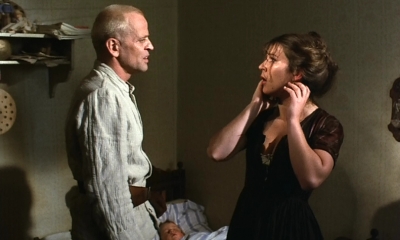
In response to her explanation that she found them, he makes a joke about being especially lucky to have found two at once. She defensively slaps his hand away, saying that she is “only human.” Kinski steps back, cracks his knuckles, and looks nervously at the floor. His response suggests an awareness regarding the true origin of the earrings which, in light of his initial lighthearted response to them, he likely reached through her ashamed response…though ironically it would seem her reaction was based on the assumption that he already knew the truth. It is a misunderstanding which heightens the sense that these two people, despite their involvement, do not really understand each other. In an attempt to regain control of himself and reestablish their connection, Kinski motions to their son, their common bond. But she remains disengaged. A few moments later, he raises from the bedside and, before exiting, stands nervously before her. While his brief focus on the child served to temporarily alleviate his tension, it could not address the central reason for his growing anxiousness. As he leaves the room, he performs the military salute, which is considered below. In addition to his entrance in this scene, the only other moment in which Kinski appears happy in this film is when he is at the town fair with his wife and son. This further emphasizes the stabilizing value he attaches to family, though the captain’s presence in the shot suggests the fallacy of this belief.
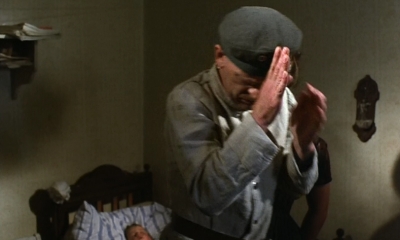
Woyzeck salutes as he leaves
Throughout Woyzeck, Kinski’s appropriation of the military salute as a strategy for regaining psychological control provides an external indication as to the internal workings of his mind. All four enactments of this gesture occur at the end of scenes in which he has experienced some form of degradation, a narrative context which reinforces our awareness that the action is an attempt to regain control. The first occurs after he has given one of his commanding officers a shave, during which he has been chided for his lack of morals and laughed at for not picking up on the absurdity of a north-south wind. The third salute (second instance described in previous paragraph) occurs after he has learned from another private that Marie likes to go dancing with an officer, and before he goes to observe this for himself. The fourth instance follows his encounter with this drunken officer, and which consisted of his being locked into a combat maneuver which left him with without air. The implications the salute has for Kinski draws on its use in an official context while also suggesting aspects of his mental state. Officially, it is used to formally signify the end of an interaction, and based on this Kinski seems to understand, or hope, that using the gesture will therefore terminate an uncomfortable interaction. We see that this is not the case when the officer from the first instance holds him in place after he makes the gesture. The use of the salute suggests the character has no self originating strategy for controlling his situation, and faced with this absence is forced to import predetermined codes from the outside. He is attempting to convert a public symbol of communication into a private source of reassurance. This element becomes more tragic as it is applied to his personal life. After learning that his wife is sleeping with another man or upon being assaulted by this man, his attempts to regain composure though the salute only highlights his lack of control and desperation for a means to stabilize himself and, as suggested by the way his hands shield his face, hide from the reality around him.
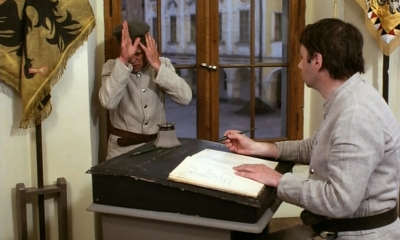
What little possibility for happiness and security does exist in his family life comes to an abrupt end when Kinski stabs his wife to death. The scene is shot in slow motion, presumably done in part to allow the viewer time to process Kinski’s changing facial expressions which if played at the standard rate might pass too quickly (unless the clip is played on fast forward, we also barely notice that he is speaking on two occasions). Between the first and second stab, Kinski’s changing expressions reveal how his attempt at maintaining a sense of rage fails and is replaced by a remorse which remains in place for the rest of the murder. When he first stabs Marie, his face displays an expression of intense fury.
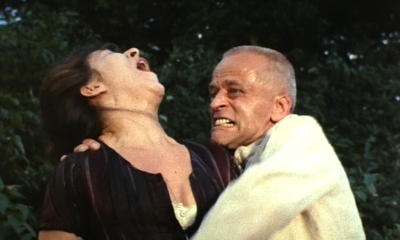
Woyzeck’s Fury
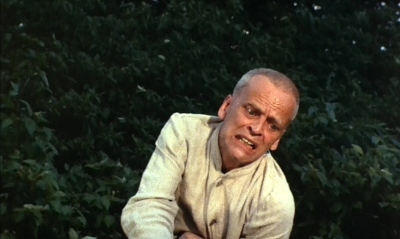
…turns to sympathy
As he watches her fall to the ground, however, his look shifts into one of sympathy. During this moment, he does not continue stabbing her, but rather looks on as she struggles to free herself. During this pause, his expression of sympathy transforms into one of horror as she continues to scream and bleed. The shock at seeing her this way seems to have overwhelmed the affection which, from the previous expression, we nonetheless know still exists within him.
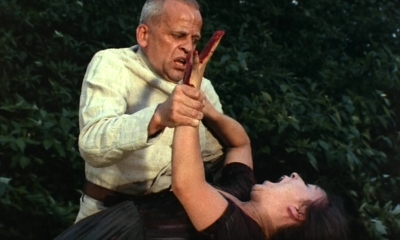
…to horror
In an effort to end the killing and thereby the source of his horror, he then raises the knife above his head and prepares to bring it down on her for a second time. His face returns to a somewhat milder version of the enraged expression which accompanied his first stab.
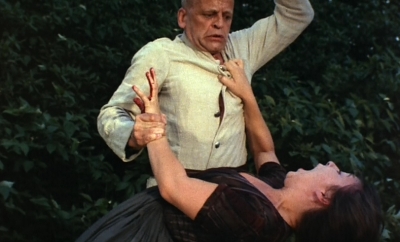
…to milder rage
His previous revelations of affection and horror, however, provide the viewer with an awareness that other sensations are working against this raw anger. As he thrusts the knife down for a second time, this anger gives way to an expression of intense sorrow. The restatement and amplification of sadness makes it clear that the second but less intense enraged expression is not so much something he actually feels, as it was an effort to bring back this state so as to make the killing easier. Rather than trying to repress his urges to kill (as was the case with Harker, for example), in this sequence he is trying to fight against the urge to let someone live.
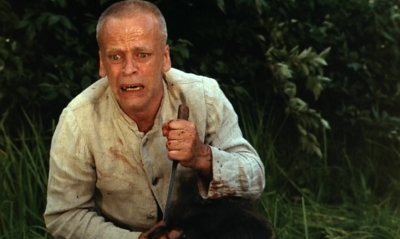
…to intense sorrow
As Fitzcarraldo, Kinski achieves a relationship with Molly (Claudia Cardinale), which offers him the support and stability which the women of the previous two films did not. The scene in which Kiniski is to give a demonstration of grand opera on his phonograph effectively illustrates both Kinski’s inability to control a situation and the redeeming impact of his female associate. It opens with a medium long shot of the party, with Cardinale standing towards the back of the frame and, from the way in which she moves her fan, quick and considerably more pronounced than another woman, we sense her apprehension regarding the reception of this recital. Her focus on Kinski is underlined when two indigenous people stroll though the imaginary line connecting her with Kinski. When they first enter, she moves slightly ahead of them to maintain an unobstructed connection with him. When she realizes they are, rather rudely, continuing in this direction which separates the semi-circle of people from Kinski and his phonograph, she quickly moves around to the other side, maintaining the unobstructed line between them.
This action establishes her as guardian to Kinski, whose enraptured expression, awkward posture, and interesting hairstyle suggest a certain unawareness. When a man enters from the left and turns off the phonograph, Kinski lunges at him, and is then apprehended by two people who attempt to escort him out the back. He violently breaks free, and rushes to his photograph. He then hastily pulls the base up of the instrument and goes to Cardinale’s side for a brief moment.
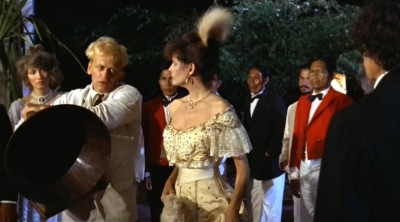
Realizing that he has lost the other piece of his instrument, he quickly returns to pick it up and then rushes back to her side for a second time. In this repeated action, the manner in which Kinski looks at her reveals his own inability to regain control and his desperation that she act to restore order. This entire sequence lasts over 83 seconds and does not contain a cut. The duration, and the medium distance framing, is typical of the way Herzog handles a number or scenes and is well suited to Kinski’s physicality.
The cut shows the host, who insults Kinski by telling him that his servants will take him to the kitchen, where his dog’s cook will make him a meal. Kinski motions offscreen for the waiter, while Cardinale focuses on the host. The waiter arrives and Kinski downs four glasses of Champagne, toasting to the dog’s cook and three of his favorite composers. About half the contents of glass makes it into his mouth. The rest spills down his chin, over his shirt, and onto the floor. This spillage indicates the mockery Kinski is making of his host’s pretense to culture by physically illustrating how it is possible to utilize the props of the refined in a manner that is vulgar. Kinski is, in effect, enacting a parody of his host’s pretense to culture.
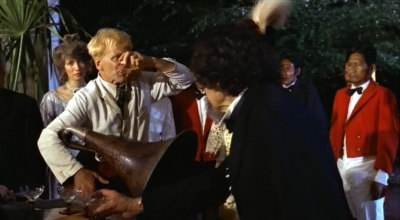
Unfortunately, his own crazed appearance and previous loss of control servers to undermine the effectiveness of this otherwise very accurate criticism of the host. After his opponent offers a toast to “Fitzcarraldo, Conquistador of the useless, cheers,” Kinski quickly moves in on him, pressing against his body with a closeness and force that prevent him from drinking his toast. This action reduces the effect of the insult by removing the follow-up drink that would offer it a sense of confirmation. Kinski then delivers his final series of comments, concluding with, “Sir, the reality of your world is nothing more that a rotten caricature of grand opera,” a line which reinforces the attack on false culture enacted during his toasts. During this engagement, Kinski maintains his eyes intensely locked on the host. On the word caricature, however, he briefly breaks the eye contact and takes in his opponent’s entire person. By not directly looking at him, Kinski reinforces that the host is not a real person, that he is a caricature, by temporarily denying him the sense of existence that accompanies being perceived.
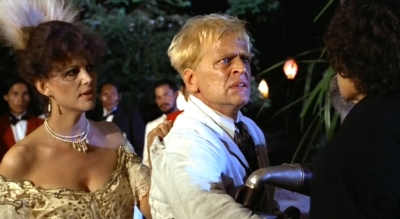
Throughout most of this exchange, Cardinale remains off to the side, looking primarily at Kinski with a sense of concern, which adds to the overall danger we associate with his mode of engagement. While Kinski’s approach to sparring with this host is impulsive and runs a great risk of making him appear even more ridiculous, Cardinale’s method is calculating and well suited to restoring their dignity. She tells Kinski that the host, being dead, is no match. The hosts responds that he is standing on his two feet, and she asks him if he is a hunting man. When he responds by asking how this is relevant, she replies “Then you should know, when you shoot an elephant, he sometimes stands for ten days before he topples over. Good night.”
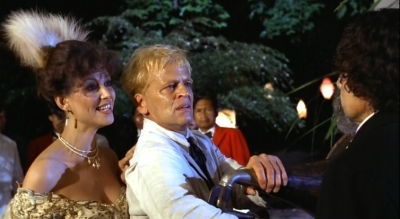
The Guardian’s retort
The exchange reveals her skill in verbal sparring, and the use of her hunting analogy shows that she is planning ahead. It is an approach in stark contrast to Kinski, who lunges from moment to moment with little to no idea where he may be headed. As she begins this last line, Kinski begins vigorously nodding his head to show he agrees with what she is saying and, at the very end, throws his head back so that he is literally looking down his nose at the host. Noticing his upward head tilt, she also raises her head back and adds the “good night,” a gesture which both reinforces the impression that they are looking down on him and beautifully captures their solidarity. Feeling empowered by her words, Kinski takes the lead by turning them abruptly to their left, his phonograph almost hitting the host in the head. While it was Cardinale that orchestrated the possibility for a dignified exit, by raising his head back and taking the initiative in their departure, Kinski attempts to take control of the situation, and behaves as though he were entirely responsible for the wonderful blows delivered by his guardian. Cardinale seems content to let this unfold until Kinski begins taking them out the back entrance, where the guards had previously tried to throw him out. Cardinale regains control and indicates that they must exit from the other side. By attempting to exit from the wrong side, Kinski belies the impression that he is in control and suggests the dangerous consequences which would accompany him if left unattended.
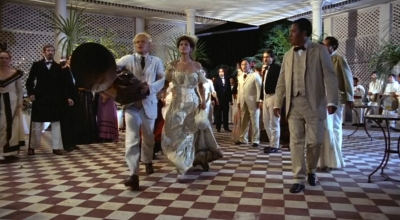
In an interview, Herzog made the following statement:
I think I do not make films in the linear way. I make the first film and the second and the third and so on. It is almost like a huge construction that I am building: one film is a cornerstone, another is the ceiling. It’s more a three-dimensional structure. I have started to make contracts with distribution companies now with a limited timing because I am telling them that, sometime toward the end of my life in this profession, I want to take possession and the rights of all my films and maybe I’ll make them into a bigger structure. Maybe I will make them into one big movie one day. [1]
It is easy to accept Herzog’s claim that his various films are part of a larger construction. But if in saying he does not make films in a linear way he means he does not develop a character in a progressive manner across various works, then his output with Kinski must be exempted from this general claim. Indeed, the first four works they made together can be read as the progressive and gradual humanization of the Kinski persona. The tyrannical Aguire is resolutely anti-human, as is made clear when he looks deep into the camera, after cutting off someone’s head, and proclaims himself the wrath of God. With Nosferatu, we have a character who desperately needs love to redeem his horrid existence, but is despite this desire unable to connect with the world of humanity. Woyzeck is officially human, but suffers from a mental illness or mild retardation that, while allowing moments of connection not afforded to a vampire, is still alienated from the redeeming power of love. Part of the power of this metanarrative is that certain moments attain heightened impact because their context is not limited to one film. For example, when Woyzeck is at the fair with his wife and child, we see him smile. That there is not one facial expression of joy in their previous two works makes this especially touching and something of a watershed moment. In Fitzcarraldo, Cardinale provides Kinski with a seemingly unconditional love which, rather than sending him into oblivion or driving him to a murderous frenzy, saves him and greatly facilitates his dream of bringing grand opera to the Amazon. While some criticism tends to see actors as accessories to the director’s vision, the real life personality of Kinski seems inextricably bound to this developing thematic. The love/hate dynamic between these two men is well documented. While obviously very speculative, it seems possible that by gradually taming the wild and unpredictable Kinski, Herzog was also attempting to humanize him…an action which, given Kinski’s apparent commitment to remaining undomesticated, could be equally considered an act of affection and aggression.
Endnotes
1 O’Toole, Lawrence. “I Feel That I’m Close to the Center of Things.” Film Comment. Vol XV nr 6 (Nov-Dec 1979); p 33-48.


